Nestled in the heart of the Peruvian Andes lies a geological marvel that has captured the world’s attention. The Rainbow Mountains, or Vinicunca, are a breathtaking spectacle of nature’s artistry.
Their vibrant stripes, ranging from deep reds to brilliant blues, have made them a must-visit destination for outdoor enthusiasts and travel bloggers alike. But what causes these mountains to display such a dazzling array of colors?
This article will delve into the science behind the Rainbow Mountains’ unique coloration. We’ll explore how the interplay of minerals and weathering processes has resulted in this stunning natural phenomenon.
We’ll also provide practical information about the Rainbow Mountains’ elevation. At over 5,000 meters above sea level, a visit to these mountains is not just a visual feast, but also a physical challenge.
Whether you’re an adventure guide seeking to enrich your knowledge or a travel blogger looking for captivating content, this guide will equip you with valuable insights. Prepare to embark on a journey to one of the most colorful corners of our planet.

Vinicunca, popularly known as the Rainbow Mountains, has become a symbol of Peru’s rich and diverse natural landscape. This Andean wonder captivates visitors with its vibrant palette, drawing countless travelers eager to witness its splendor firsthand.
Located in the Cusco region, these mountains are a testament to the earth’s ancient artistry, with colors that seem almost surreal. Each hue tells a story, a chapter in the geological history that unfolded over millions of years. From afar, the mountains appear as though an artist has delicately painted bold stripes of red, gold, pink, and turquoise across them.
This mesmerizing effect occurs due to layers of sediments exposed over centuries. The interplay of these layers with various minerals, including iron oxide and copper sulfate, creates the vivid tapestry you see today. Such a spectacle doesn’t just happen overnight; it’s a magnificent result of erosion and tectonic shifts.
Standing amidst such beauty, one can’t help but feel a profound connection to the natural world. The Rainbow Mountains offer more than just a visual feast; they provide a tactile sense of the planet’s evolving story. This allure makes them a sought-after destination, celebrated not only for their beauty but also for their cultural and geological significance.
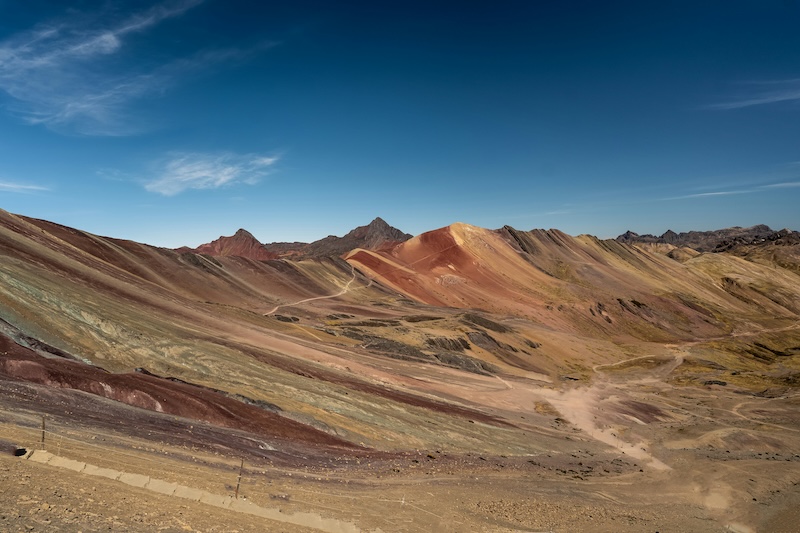
The striking colors of the Rainbow Mountains result from millions of years of geological processes. These vibrant hues are a direct consequence of mineralogical and environmental interactions over millennia. This process makes the peaks appear like magnificent rainbows grounded on earth.
Different minerals define each color seen on the slopes of Vinicunca. Iron oxide gives the mountains their red tint, while greenish layers owe their color to copper sulfate. Other colors come from a variety of mineral deposits, like yellow from sulfur compounds and white from quartz or sandstone.
The formation of these layers traces back to a period when the region lay submerged under the sea. Layers of sediment accumulated on the ocean floor, rich in these minerals. Over time, tectonic activity pushed these layers upward, crafting the Andes Mountains we see today.
Yet, the story doesn’t end with sedimentation and tectonics. Erosion played an equally crucial role. The forces of wind and water gradually wore away the upper layers. This exposure allowed the vibrant underlying colors to display their grandeur fully.
This interplay between geological forces and mineral compositions offers insight into Earth’s complex makeup. Not only do these hues beautify the mountains, but they also provide a window into the dynamic processes that shape our planet.
For those fascinated by geology, the Rainbow Mountains in Peru stand as a remarkable showcase. Here’s a summary of the key minerals and their contributions to the mountains’ colors:
Understanding this geological marvel elevates the visiting experience, offering not just visual splendor but a scientific journey through time. This rare combination of geological art and science invites both wonder and appreciation from all who trek its paths.

The Rainbow Mountain Peru Elevation is at 5,200 meters (17,060 feet) above sea level. Rainbow Mountain Elevation places it among the higher peaks in the Andes, challenging even seasoned hikers with its thin air.
At such heights, the air holds much less oxygen than at sea level. This can pose significant challenges for visitors unaccustomed to high altitudes. Despite the arduous climb, reaching the summit rewards hikers with a breathtaking panorama that spans snow-capped peaks and vibrant valleys.
Acclimatization is crucial before tackling this altitude. Spending a few days in Cusco or other nearby locations can aid your body in adjusting to the diminished oxygen levels. This preparation is essential to enjoy the full experience without the discomfort of altitude sickness.
Ascending the Rainbow Mountain is not just a physical challenge. It’s a journey that pushes personal limits. It offers a unique perspective on the sheer majesty of Andean landscapes and the incredible heights the human spirit can achieve.
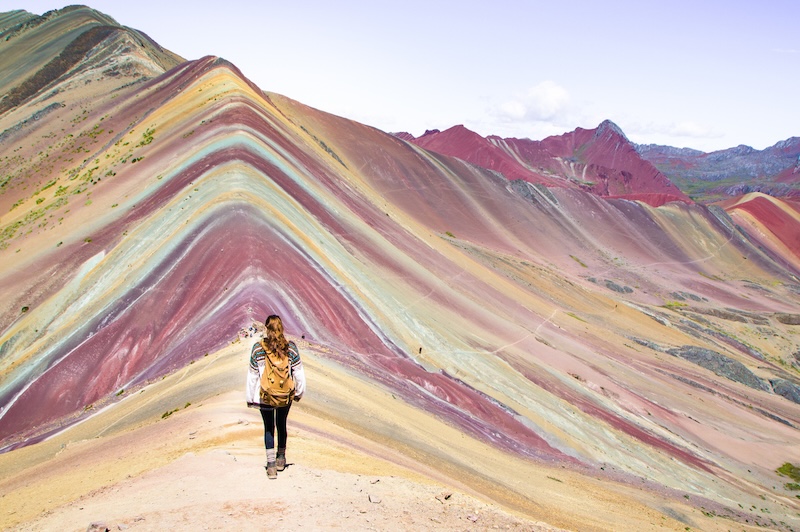
Preparing to conquer the elevation of Rainbow Mountains in Peru requires both physical and mental readiness. Acclimatization is key to ensuring a safe and enjoyable hike.
Start your journey in Cusco or another high-altitude town. Spend at least two days here before attempting the hike. This allows your body to adapt to the reduced oxygen levels.
Hydration plays a vital role in preventing altitude sickness. Drink plenty of water throughout your stay. This will help your body cope with the thin air.
Eat light meals rich in carbohydrates. Foods such as grains and potatoes provide energy and are easier to digest at high altitudes. Avoid alcohol and caffeine, which can dehydrate you and worsen symptoms.
Plan a gradual ascent, taking breaks along the way. Listen to your body. If you feel dizzy or nauseous, stop and rest. Descend if symptoms don’t improve.
Consider bringing altitude sickness medication. Consult with a physician before your trip. Using such medication can mitigate symptoms and make your ascent more manageable.
By preparing well, you can enjoy the incredible beauty of Rainbow Mountain, minimizing discomfort and maximizing your adventure.
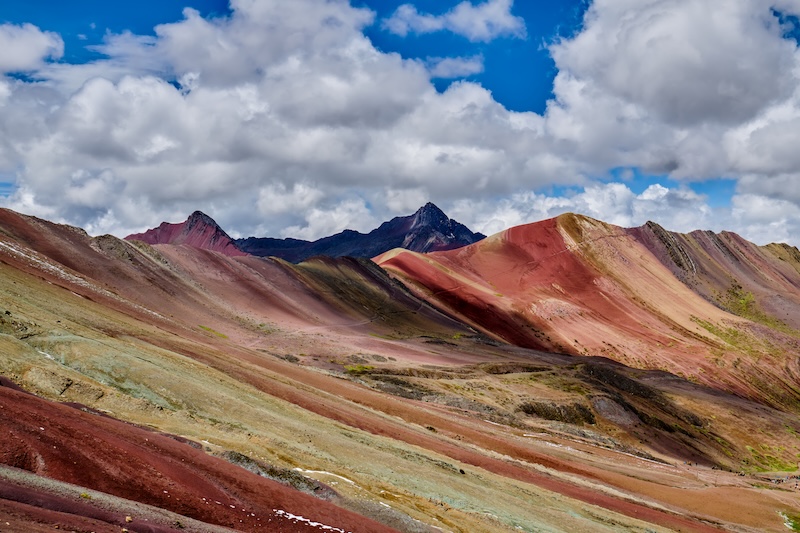
Timing your visit to the Rainbow Mountains in Peru is crucial for a successful experience. The dry season, from May to September, offers the best conditions. During this period, clear skies allow the vibrant hues of the mountains to shine unobstructed.
The dry season also means more reliable weather for hiking. Trails are less likely to be muddy, making the trek smoother. However, colder temperatures warrant dressing in layers to stay comfortable during the chillier mornings and evenings.
Visiting during the wet season, between October and April, presents challenges. Increased rainfall can obscure the colors of the mountains and make trails slippery. However, fewer crowds offer a quieter experience, ideal if you seek solitude.
Plan your trek early in the morning, regardless of the season. Early starts help avoid afternoon rains and offer soft lighting, enhancing the captivating beauty of this geological wonder. This strategic timing also provides more opportunities to enjoy the panoramic views without the day’s heat or crowds.

Embarking on the trek to the Rainbow Mountains in Peru is a rewarding adventure. Whether you choose a day trip or a multi-day experience, the journey is unforgettable. Both options are available for varying interests and fitness levels.
Day hikers often depart from Cusco in the early morning hours. The journey involves a few hours by car to reach the trailhead at K’ayrawiri. This option suits those with limited time, offering a glimpse of the vibrant landscape.
For a more immersive experience, consider multi-day treks. The Ausangate Circuit provides an extended opportunity to explore beyond Vinicunca. This route captures more of the scenic surroundings, including stunning lakes and glaciers.
The trail to the Rainbow Mountains is moderate to challenging. Elevation gain can be taxing, so a good physical condition is essential. However, it’s worth the effort for the breathtaking views that await hikers at the top.
Expect to encounter dramatic landscapes along the way. Snow-capped peaks, rugged terrain, and wildlife sightings add a unique dimension to the adventure. Vicuñas, alpacas, and, if you’re lucky, the majestic Andean condor may grace your path.
Guided tours enhance the experience with expert knowledge and cultural insights. Local guides share stories of the mountains’ significance and provide safety and navigation assistance. Their expertise enriches the journey, creating a deeper connection with the Andean environment.
When embarking on this trek, remember preparation is key. Essential items include layered clothing, sunscreen, water, and sturdy boots.
Armed with the right gear and information, you’ll enjoy one of Peru’s most awe-inspiring hikes. The journey promises not only stunning visuals but also a profound appreciation for this geological masterpiece.
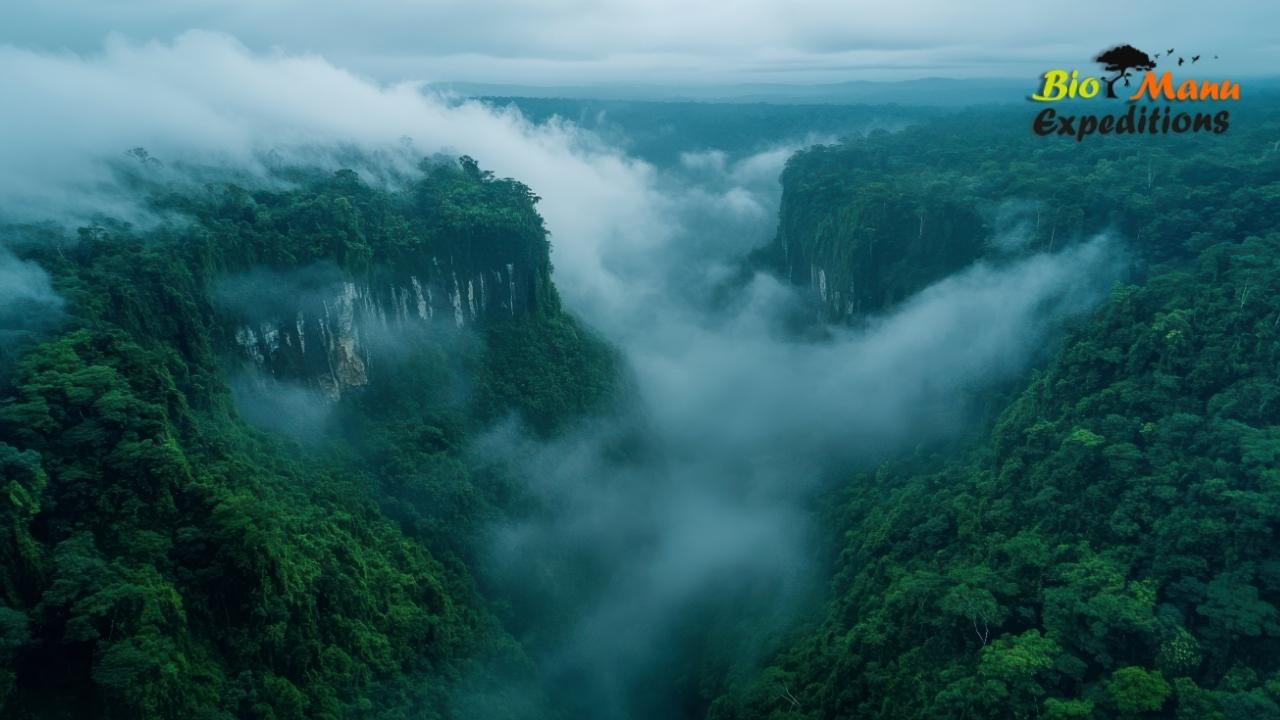
For those seeking to extend their Peruvian adventure beyond the Rainbow Mountains, the Manu National Park offers an enchanting escape. This UNESCO World Heritage Site is renowned for its biodiversity and vibrant ecosystems.
Nestled within the Amazon basin, Manu is a lush tapestry of forests and wildlife. The park is home to an incredible variety of plant and animal species, making it a paradise for nature enthusiasts. Unique creatures like jaguars and giant otters roam these expansive grounds.
The Manu Rainforest Tour provides immersive encounters with this rich wilderness. Guided tours allow for safe exploration while offering informative insights into the flora and fauna. Birdwatching here is unparalleled, with over a thousand species thriving in the treetops.
Beyond wildlife, the park holds cultural significance. Indigenous communities maintain deep-rooted traditions in the area. Visiting provides opportunities to learn about these cultures, as well as the natural harmony they embody.
Combining a trip to the Rainbow Mountains with an excursion to Manu presents a comprehensive view of Peru’s diverse landscapes. From towering peaks to expansive rainforests, the contrast underscores the country’s ecological wonders. Together, these experiences reveal the splendor of nature in its many forms, making for an unforgettable journey.
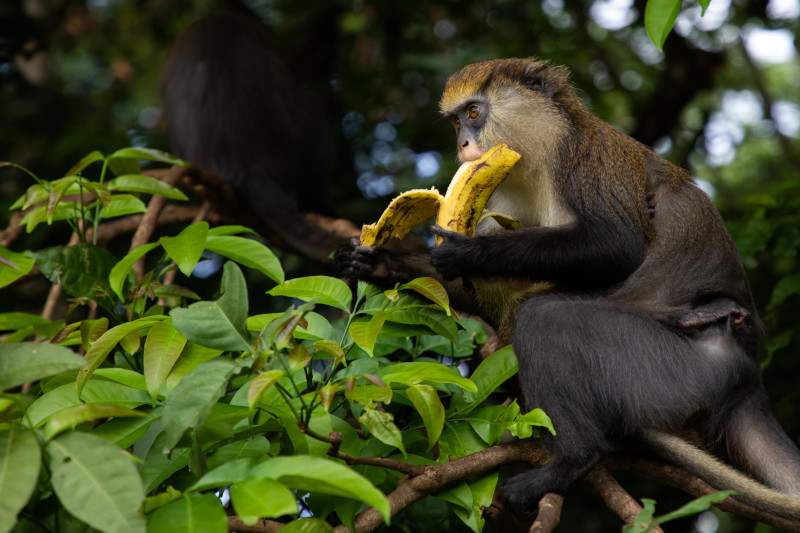
The Ausangate mountain is not just a natural marvel but a vital cultural landmark for the Andean people. Its towering presence is revered as sacred, woven into the spiritual fabric of the Quechua communities.
Deep respect for Ausangate is expressed through traditional festivals and rituals. These practices highlight the Andean belief in Pachamama, or Mother Earth, acknowledging the sustenance she provides. This connection to nature is both profound and practical, guiding the community’s way of life.
Visitors have the chance to observe these cultural expressions firsthand. Attending local gatherings offers insight into the deep-rooted traditions that endure amidst modernity. Engaging with the Quechua people fosters cultural exchange, enriching the travel experience.
Beyond cultural insights, respecting local customs enhances the journey. Visitors are encouraged to participate mindfully, ensuring their presence honors the sacred nature of Ausangate. By doing so, travelers not only explore Peru’s landscapes but also its living heritage.

The Rainbow Mountains’ vibrant hues and dramatic landscapes have captured global attention. With increased tourism, however, comes the responsibility to protect this fragile environment. Sustainable travel practices ensure that this natural wonder is preserved for future explorers.
Travelers should prioritize eco-friendly practices when visiting. By following “Leave No Trace” principles, visitors can minimize their impact on the delicate ecosystem. This approach includes being mindful of waste and respecting wildlife habitats.
Participation in guided tours with local operators also promotes sustainability. These tours provide insight into the cultural and environmental significance of the area. Guides often share knowledge on conservation efforts, enhancing appreciation for the landscape.
Ultimately, conscious travel choices help safeguard the Rainbow Mountains. Through sustainable practices, visitors contribute to the preservation of this extraordinary site.
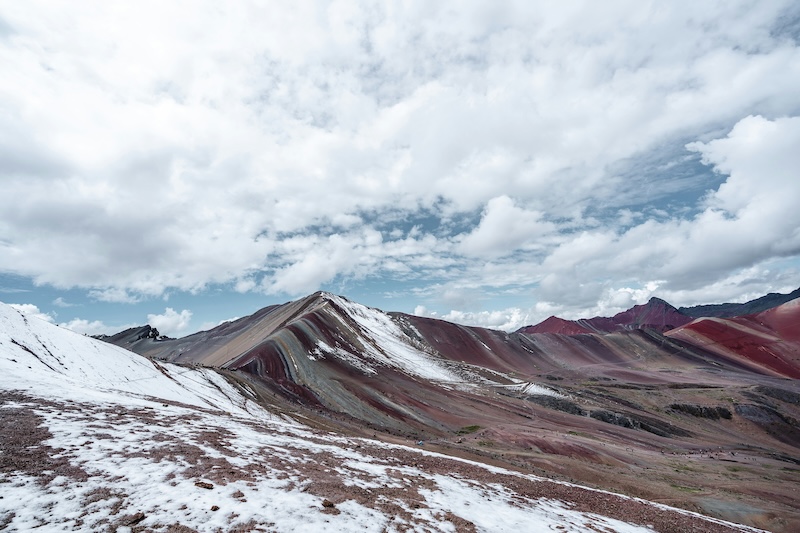
Photographing the Rainbow Mountains is a dream for many travel bloggers. The vibrant bands of color offer unparalleled subjects. Timing and technique are key to capturing their splendor.
Arriving early or late in the day can enhance your shots. The soft, golden light during these times accentuates the colors. Avoiding the harsh midday sun ensures better contrast and depth.
Composition plays a vital role in conveying the scene’s grandeur. Wide-angle lenses can capture the sweeping vistas. Consider using natural elements like clouds or shadows for added interest.
Finally, be patient and adaptable. Weather in the Andes is unpredictable, offering dynamic skies. Embrace changes as opportunities for unique photography. Engaging with the landscape’s mood can result in remarkable images.

Guiding adventurers to the Rainbow Mountains requires preparation. The high altitude and remote location mean having the right equipment is crucial. Ensuring safety and comfort for clients should be the top priority.
Firstly, proper clothing is essential. Layering is key in the Andes due to fluctuating temperatures. Guides should carry waterproof jackets and thermal gear for warmth and rain protection. Sun protection is also necessary due to strong UV exposure at high elevations.
Footwear is another critical consideration. Sturdy, well-fitting hiking boots provide support on the rugged terrain. It’s important to advise clients on suitable footwear to prevent injuries. Encouraging regular maintenance can extend the life of this essential gear.
Being prepared ensures a memorable and safe experience for everyone involved. As a guide, your leadership and preparedness set the stage for an unforgettable adventure.
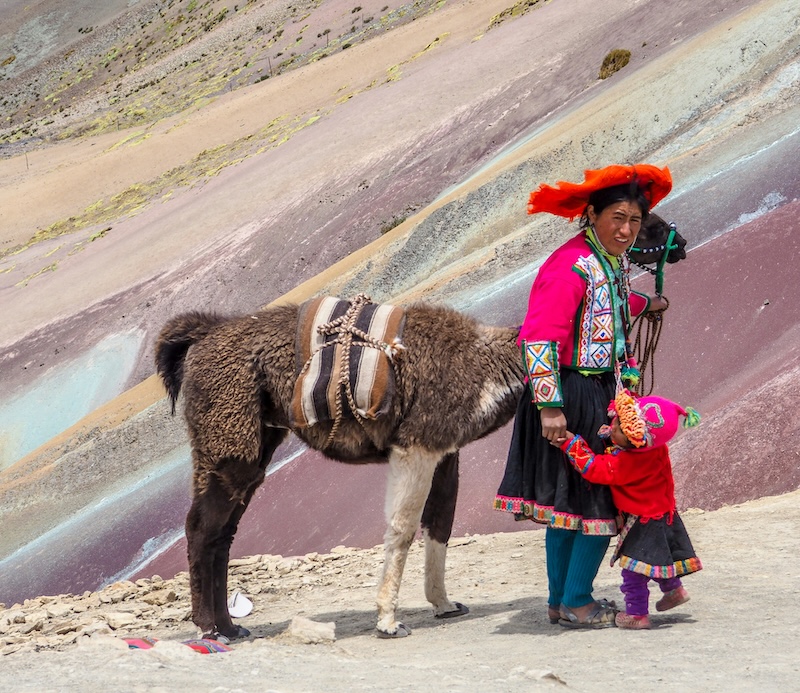
The Rainbow Mountains in Peru remain a breathtaking spectacle. Their vivid colors and soaring elevation captivate all who visit. Their unique beauty is a testament to the natural wonders Peru offers.
For travel bloggers and outdoor guides alike, these mountains are a source of endless inspiration. Each trek holds the promise of discovery and personal achievement. The surrounding landscapes and vibrant cultural traditions enrich the experience further.
Embracing the spirit of adventure while respecting this delicate ecosystem ensures its preservation for future generations. Peru’s Rainbow Mountains continue to enchant visitors, leaving them with memories that last a lifetime.
If you got any questions, please do not hesitate to send us a message. We reply within 24 hours!
+51 900 394 399
info@biomanuexpeditions.com
reservas@biomanuexpeditions.com
